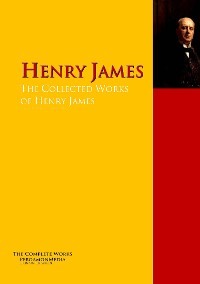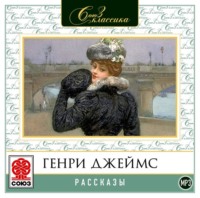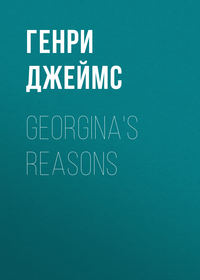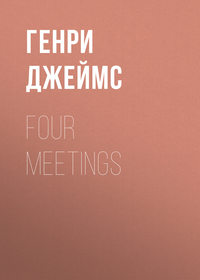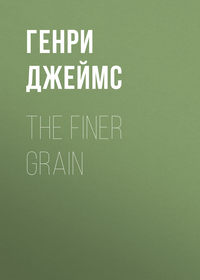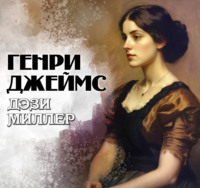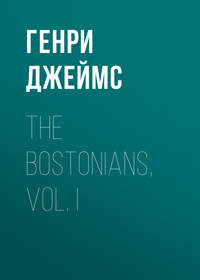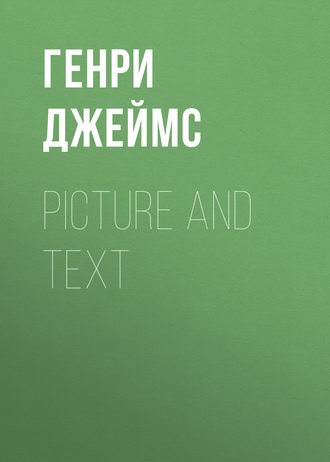 полная версия
полная версияPicture and Text

Henry James
Picture and Text / 1893
NOTE
Two of the following papers were originally published, with illustrations, in Harper’s Magazine and the title of one of them—the first of titles has been altered from “Our Artists in Europe.” The other, the article on Mr. Sargent, was accompanied by reproductions of several of his portraits. The notice of Mr. Abbey and that of Mr. Reinhart appeared in Harper’s Weekly. That of Mr. Alfred Parsons figured as an introduction to the catalogue of an exhibition of his pictures. The sketch of Daumier was first contributed to The Century, and “After the Play” to The New Review.
BLACK AND WHITE
If there be nothing new under the sun there are some things a good deal less old than others. The illustration of books, and even more of magazines, may be said to have been born in our time, so far as variety and abundance are the signs of it; or born, at any rate, the comprehensive, ingenious, sympathetic spirit in which we conceive and practise it.
If the centuries are ever arraigned at some bar of justice to answer in regard to what they have given, of good or of bad, to humanity, our interesting age (which certainly is not open to the charge of having stood with its hands in its pockets) might perhaps do worse than put forth the plea of having contributed a fresh interest in “black and white.” The claim may now be made with the more confidence from the very evident circumstance that this interest is far from exhausted. These pages are an excellent place for such an assumption. In Harper they have again and again, as it were, illustrated the illustration, and they constitute for the artist a series of invitations, provocations and opportunities. They may be referred to without arrogance in support of the contention that the limits of this large movement, with all its new and rare refinement, are not yet in sight.
I
It is on the contrary the constant extension that is visible, with the attendant circumstances of multiplied experiment and intensified research—circumstances that lately pressed once more on the attention of the writer of these remarks on his finding himself in the particular spot which history will perhaps associate most with the charming revival. A very old English village, lying among its meadows and hedges, in the very heart of the country, in a hollow of the green hills of Worcestershire, is responsible directly and indirectly for some of the most beautiful work in black and white with which I am at liberty to concern myself here; in other words, for much of the work of Mr. Abbey and Mr. Alfred Parsons. I do not mean that Broadway has told these gentlemen all they know (the name, from which the American reader has to brush away an incongruous association, may as well be written first as last); for Mr. Parsons, in particular, who knows everything that can be known about English fields and flowers, would have good reason to insist that the measure of his large landscape art is a large experience. I only suggest that if one loves Broadway and is familiar with it, and if a part of that predilection is that one has seen Mr. Abbey and Mr. Parsons at work there, the pleasant confusion takes place of itself; one’s affection for the wide, long, grass-bordered vista of brownish gray cottages, thatched, latticed, mottled, mended, ivied, immemorial, grows with the sense of its having ministered to other minds and transferred itself to other recipients; just as the beauty of many a bit in many a drawing of the artists I have mentioned is enhanced by the sense, or at any rate by the desire, of recognition. Broadway and much of the land about it are in short the perfection of the old English rural tradition, and if they do not underlie all the combinations by which (in their pictorial accompaniments to rediscovered ballads, their vignettes to story or sonnet) these particular talents touch us almost to tears, we feel at least that they would have sufficed: they cover the scale.
In regard, however, to the implications and explications of this perfection of a village, primarily and to be just, Broadway is, more than any one else. Mr. Frank Millet. Mr. Laurence Hutton discovered but Mr. Millet appropriated it: its sweetness was wasted until he began to distil and bottle it. He disinterred the treasure, and with impetuous liberality made us sharers in his fortune. His own work, moreover, betrays him, as well as the gratitude of participants, as I could easily prove if it did not perversely happen that he has commemorated most of his impressions in color. That excludes them from the small space here at my command; otherwise I could testify to the identity of old nooks and old objects, those that constitute both out-of-door and in-door furniture.
In such places as Broadway, and it is part of the charm of them to American eyes, the sky looks down on almost as many “things” as the ceiling, and “things” are the joy of the illustrator. Furnished apartments are useful to the artist, but a furnished country is still more to his purpose. A ripe midland English region is a museum of accessories and specimens, and is sure, under any circumstances, to contain the article wanted. This is the great recommendation of Broadway; everything in it is convertible. Even the passing visitor finds himself becoming so; the place has so much character that it rubs off on him, and if in an old garden—an old garden with old gates and old walls and old summer-houses—he lies down on the old grass (on an immemorial rug, no doubt), it is ten to one but that he will be converted. The little oblong sheaves of blank paper with elastic straps are fluttering all over the place. There is portraiture in the air and composition in the very accidents. Everything is a subject or an effect, a “bit” or a good thing. It is always some kind of day; if it be not one kind it is another. The garden walls, the mossy roofs, the open doorways and brown interiors, the old-fashioned flowers, the bushes in figures, the geese on the green, the patches, the jumbles, the glimpses, the color, the surface, the general complexion of things, have all a value, a reference and an application. If they are a matter of appreciation, that is why the gray-brown houses are perhaps more brown than gray, and more yellow than either. They are various things in turn, according to lights and days and needs. It is a question of color (all consciousness at Broadway is that), but the irresponsible profane are not called upon to settle the tint.
It is delicious to be at Broadway and to be one of the irresponsible profane—not to have to draw. The single street is in the grand style, sloping slowly upward to the base of the hills for a mile, but you may enjoy it without a carking care as to how to “render” the perspective. Everything is stone except the general greenness—a charming smooth local stone, which looks as if it had been meant for great constructions and appears even in dry weather to have been washed and varnished by the rain. Half-way up the road, in the widest place, where the coaches used to turn (there were many of old, but the traffic of Broadway was blown to pieces by steam, though the destroyer has not come nearer than half a dozen miles), a great gabled mansion, which was once a manor or a house of state, and is now a rambling inn, stands looking at a detached swinging sign which is almost as big as itself—a very grand sign, the “arms” of an old family, on the top of a very tall post. You will find something very like the place among Mr. Abbey’s delightful illustrations to, “She Stoops to Conquer.” When the September day grows dim and some of the windows glow, you may look out, if you like, for Tony Lumpkin’s red coat in the doorway or imagine Miss Hardcastle’s quilted petticoat on the stair.
II
It is characteristic of Mr. Frank Millet’s checkered career, with opposites so much mingled in it, that such work as he has done for Harper should have had as little in common as possible with midland English scenery. He has been less a producer in black and white than a promoter and, as I may say, a protector of such production in others; but none the less the back volumes of Harper testify to the activity of his pencil as well as to the variety of his interests. There was a time when he drew little else but Cossacks and Orientals, and drew them as one who had good cause to be vivid. Of the young generation he was the first to know the Russian plastically, especially the Russian soldier, and he had paid heavily for his acquaintance. During the Russo-Turkish war he was correspondent in the field (with the victors) of the New York Herald and the London Daily News—a capacity in which he made many out-of-the-way, many precious, observations. He has seen strange countries—the East and the South and the West and the North—and practised many arts. To the London Graphic, in 1877 he sent striking sketches from the East, as well as capital prose to the journals I have mentioned. He has always been as capable of writing a text for his own sketches as of making sketches for the text of others. He has made pictures without words and words without pictures. He has written some very clever ghost-stories, and drawn and painted some very immediate realities. He has lately given himself up to these latter objects, and discovered that they have mysteries more absorbing than any others. I find in Harper, in 1885. “A Wild-goose Chase” through North Germany and Denmark, in which both pencil and pen are Mr. Millet’s, and both show the natural and the trained observer.
He knows the art-schools of the Continent, the studios of Paris, the “dodges” of Antwerp, the subjects, the models of Venice, and has had much æsthetic as well as much personal experience. He has draped and distributed Greek plays at Harvard, as well as ridden over Balkans to post pressing letters, and given publicity to English villages in which susceptible Americans may get the strongest sensations with the least trouble to themselves. If the trouble in each case will have been largely his, this is but congruous with the fact that he has not only found time to have a great deal of history himself, but has suffered himself to be converted by others into an element—beneficent I should call it if discretion did not forbid me—of their history. Springing from a very old New England stock, he has found the practice of art a wonderful antidote, in his own language, “for belated Puritanism.” He is very modern, in the sense of having tried many things and availed himself of all of the facilities of his time; but especially on this ground of having fought out for himself the battle of the Puritan habit and the æsthetic experiment. His experiment was admirably successful from the moment that the Puritan levity was forced to consent to its becoming a serious one. In other words, if Mr. Millet is artistically interesting to-day (and to the author of these remarks he is highly so), it is because he is a striking example of what the typical American quality can achieve.
He began by having an excellent pencil, because as a thoroughly practical man he could not possibly have had a weak one. But nothing is more remunerative to follow than the stages by which “faculty” in general (which is what I mean by the characteristic American quality) has become the particular faculty; so that if in the artist’s present work one recognizes—recognizes even fondly—the national handiness, it is as handiness regenerate and transfigured. The American adaptiveness has become a Dutch finish. The only criticism I have to make is of the preordained paucity of Mr. Millet’s drawings; for my mission is not to speak of his work in oils, every year more important (as was indicated by the brilliant interior with figures that greeted the spectator in so friendly a fashion on the threshold of the Royal Academy exhibition of 1888), nor to say that it is illustration too—illustration of any old-fashioned song or story that hums in the brain or haunts the memory—nor even to hint that the admirable rendering of the charming old objects with which it deals (among which I include the human face and figure in dresses unfolded from the lavender of the past), the old surfaces and tones, the stuffs and textures, the old mahogany and silver and brass—the old sentiment too, and the old picture-making vision—are in the direct tradition of Terburg and De Hoogh and Metzu.
III
There is no paucity about Mr. Abbey as a virtuoso in black and white, and if one thing more than another sets the seal upon the quality of his work, it is the rare abundance in which it is produced. It is not a frequent thing to find combinations infinite as well as exquisite. Mr. Abbey has so many ideas, and the gates of composition have been opened so wide to him, that we cultivate his company with a mixture of confidence and excitement. The readers of Harper have had for years a great deal of it, and they will easily recognize the feeling I allude to—the expectation of familiarity in variety. The beautiful art and taste, the admirable execution, strike the hour with the same note; but the figure, the scene, is ever a fresh conception. Never was ripe skill less mechanical, and never was the faculty of perpetual evocation less addicted to prudent economies. Mr. Abbey never saves for the next picture, yet the next picture will be as expensive as the last. His whole career has been open to the readers of Harper, so that what they may enjoy on any particular occasion is not only the talent, but a kind of affectionate sense of the history of the talent, That history is, from the beginning, in these pages, and it is one of the most interesting and instructive, just as the talent is one of the richest and the most sympathetic in the art-annals of our generation. I may as well frankly declare that I have such a taste for Mr. Abbey’s work that I cannot affect a judicial tone about it. Criticism is appreciation or it is nothing, and an intelligence of the matter in hand is recorded more substantially in a single positive sign of such appreciation than in a volume of sapient objections for objection’s sake—the cheapest of all literary commodities. Silence is the perfection of disapproval, and it has the great merit of leaving the value of speech, when the moment comes for it, unimpaired.
Accordingly it is important to translate as adequately as possible the positive side of Mr. Abbey’s activity. None to-day is more charming, and none helps us more to take the large, joyous, observant, various view of the business of art. He has enlarged the idea of illustration, and he plays with it in a hundred spontaneous, ingenious ways. “Truth and poetry” is the motto legibly stamped upon his pencil-case, for if he has on the one side a singular sense of the familiar, salient, importunate facts of life, on the other they reproduce themselves in his mind in a delightfully qualifying medium. It is this medium that the fond observer must especially envy Mr. Abbey, and that a literary observer will envy him most of all.
Such a hapless personage, who may have spent hours in trying to produce something of the same result by sadly different means, will measure the difference between the roundabout, faint descriptive tokens of respectable prose and the immediate projection of the figure by the pencil. A charming story-teller indeed he would be who should write as Mr. Abbey draws. However, what is style for one art is style for other, so blessed is the fraternity that binds them together, and the worker in words may take a lesson from the picture-maker of “She Stoops to Conquer.” It is true that what the verbal artist would like to do would be to find out the secret of the pictorial, to drink at the same fountain. Mr. Abbey is essentially one of those who would tell us if he could, and conduct us to the magic spring; but here he is in the nature of the case helpless, for the happy ambiente as the Italians call it, in which his creations move is exactly the thing, as I take it, that he can least give an account of. It is a matter of genius and imagination—one of those things that a man determines for himself as little as he determines the color of his eyes. How, for instance, can Mr. Abbey explain the manner in which he directly observes figures, scenes, places, that exist only in the fairy-land of his fancy? For the peculiar sign of his talent is surely this observation in the remote. It brings the remote near to us, but such a complicated journey as it must first have had to make! Remote in time (in differing degrees), remote in place, remote in feeling, in habit, and in their ambient air, are the images that spring from his pencil, and yet all so vividly, so minutely, so consistently seen! Where does he see them, where does he find them, how does he catch them, and in what language does he delightfully converse with them? In what mystic recesses of space does the revelation descend upon him?
The questions flow from the beguiled but puzzled admirer, and their tenor sufficiently expresses the claim I make for the admirable artist when I say that his truth is interfused with poetry. He spurns the literal and yet superabounds in the characteristic, and if he makes the strange familiar he makes the familiar just strange enough to be distinguished. Everything is so human, so humorous and so caught in the act, so buttoned and petticoated and gartered, that it might be round the corner; and so it is—but the corner is the corner of another world. In that other world Mr. Abbey went forth to dwell in extreme youth, as I need scarcely be at pains to remind those who have followed him in Harper. It is not important here to give a catalogue of his contributions to that journal: turn to the back volumes and you will meet him at every step. Every one remembers his young, tentative, prelusive illustrations to Herrick, in which there are the prettiest glimpses, guesses and foreknowledge of the effects he was to make completely his own. The Herrick was done mainly, if I mistake not, before he had been to England, and it remains, in the light of this fact, a singularly touching as well as a singularly promising performance. The eye of sense in such a case had to be to a rare extent the mind’s eye, and this convertibility of the two organs has persisted.
From the first and always that other world and that qualifying medium in which I have said that the human spectacle goes on for Mr. Abbey have been a county of old England which is not to be found in any geography, though it borders, as I have hinted, on the Worcestershire Broadway. Few artistic phenomena are more curious than the congenital acquaintance of this perverse young Philadelphian with that mysterious locality. It is there that he finds them all—the nooks, the corners, the people, the clothes, the arbors and gardens and teahouses, the queer courts of old inns, the sun-warmed angles of old parapets. I ought to have mentioned for completeness, in addition to his pictures to Goldsmith and to the scraps of homely British song (this latter class has contained some of his most exquisite work), his delicate drawing’s for Mr. William Black’s Judith Shakespeare. And in relation to that distinguished name—I don’t mean Mr. Black’s—it is a comfort, if I may be allowed the expression, to know that (as, to the best of my belief, I violate no confidence in saying) he is even now engaged in the great work of illustrating the comedies. He is busy with “The Merchant of Venice;” he is up to his neck in studies, in rehearsals. Here again, while in prevision I admire the result, what I can least refrain from expressing is a sort of envy of the process, knowing what it is with Mr. Abbey and what explorations of the delightful it entails—arduous, indefatigable, till the end seems almost smothered in the means (such material complications they engender), but making one’s daily task a thing of beauty and honor and beneficence.
IV
Even if Mr. Alfred Parsons were not a masterly contributor to the pages of Harper, it would still be almost inevitable to speak of him after speaking of Mr. Abbey, for the definite reason (I hope that in giving it I may not appear to invade too grossly the domain of private life) that these gentlemen are united in domestic circumstance as well as associated in the nature of their work. In London, in the relatively lucid air of Campden Hill, they dwell together, and their beautiful studios are side by side. However, there is a reason for commemorating Mr. Parsons’ work which has nothing to do with the accidental—the simple fact that that work forms the richest illustration of the English landscape that is offered us to-day. Harper has for a long time past been full of Mr. Alfred Parsons, who has made the dense, fine detail of his native land familiar in far countries, amid scenery of a very different type. This is what the modern illustration can do when the ripeness of the modern sense is brought to it and the wood-cutter plays with difficulties as the brilliant Americans do to-day, following his original at a breakneck pace. An illusion is produced which, in its very completeness, makes one cast an uneasy eye over the dwindling fields that are still left to conquer. Such art as Alfred Parsons’—such an accomplished translation of local aspects, translated in its turn by cunning hands and diffused by a wonderful system of periodicity through vast and remote communities, has, I confess, in a peculiar degree, the effect that so many things have in this age of multiplication—that of suppressing intervals and differences and making the globe seem alarmingly small. Vivid and repeated evocations of English rural things—the meadows and lanes, the sedgy streams, the old orchards and timbered houses, the stout, individual, insular trees, the flowers under the hedge and in it and over it, the sweet rich country seen from the slope, the bend of the unformidable river, the actual romance of the castle against the sky, the place on the hill-side where the gray church begins to peep (a peaceful little grassy path leads up to it over a stile)—all this brings about a terrible displacement of the very objects that make pilgrimage a passion, and hurries forward that ambiguous advantage which I don’t envy our grandchildren, that of knowing all about everything in advance, having trotted round the globe annually in the magazines and lost the bloom of personal experience. It is a part of the general abolition of mystery with which we are all so complacently busy today. One would like to retire to another planet with a box of Mr. Parsons’ drawings, and be homesick there for the pleasant places they commemorate.
There are many things to be said about his talent, some of which are not the easiest in the world to express. I shall not, however, make them more difficult by attempting to catalogue his contributions in these pages. A turning of the leaves of Harper brings one constantly face to face with him, and a systematic search speedily makes one intimate. The reader will remember the beautiful Illustrations to Mr. Blackmore’s novel of Springhaven, which were interspersed with striking figure-pieces from the pencil of that very peculiar pictorial humorist Mr. Frederick Barnard, who, allowing for the fact that he always seems a little too much to be drawing for Dickens and that the footlights are the illumination of his scenic world, has so remarkable a sense of English types and attitudes, costumes and accessories, in what may be called the great-coat-and-gaiters period—the period when people were stiff with riding and wicked conspiracies went forward in sanded provincial inn-parlors. Mr. Alfred Parsons, who is still conveniently young, waked to his first vision of pleasant material in the comprehensive county of Somerset—a capital centre of impression for a painter of the bucolic. He has been to America; he has even reproduced with remarkable discrimination and truth some of the way-side objects of that country, not making them look in the least like their English equivalents, if equivalents they may be said to have. Was it there that Mr. Parsons learned so well how Americans would like England to appear? I ask this idle question simply because the England of his pencil, and not less of his brush (of his eminent brush there would be much to say), is exactly the England that the American imagination, restricted to itself, constructs from the poets, the novelists, from all the delightful testimony it inherits. It was scarcely to have been supposed possible that the native point of view would embrace and observe so many of the things that the more or less famished outsider is, in vulgar parlance, “after.” In other words (though I appear to utter a foolish paradox), the danger might have been that Mr. Parsons knew his subject too well to feel it—to feel it, I mean, à l’Américaine. He is as tender of it as if he were vague about it, and as certain of it as if he were blasé.


